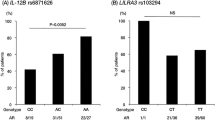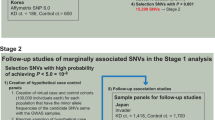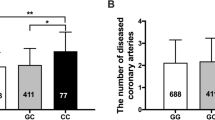Abstract
Buerger disease (BD) and Takayasu arteritis (TA) are rare vascular disorders. Although their etiology and pathogenesis have not been elucidated, several studies have suggested the involvement of innate immunity. Myeloid differentiation primary-response protein 88 (MyD88) is a key signaling adaptor for all Toll-like receptors, which have a central role in innate immunity. In the present study, we evaluated the association of MyD88 with BD and TA. We conducted case–control studies in Japanese populations composing of 131 BD cases, 90 TA cases and 270 healthy controls to be genotyped for a single nucleotide polymorphism rs7744 A>G in the 3′-untranslated region of MyD88 gene. The frequency of GG genotype was significantly lower in the BD patients than in the controls (6.9 vs 15.9%, P=0.011, odds ratio=0.39, 95% confidence interval; 0.19, 0.81), although there was no significant difference in the genotype frequencies between the TA patients and controls. It was suggested that MyD88 may confer resistance to BD in Japanese. Because this is the first report of the association between MyD88 and BD, replication studies in other cohorts are required.
Similar content being viewed by others
Main
Buerger disease (BD) and Takayasu arteritis (TA) are rare vascular diseases. BD affects small and medium sized arteries and veins. Smoking and periodontitis are well-known risk factors of BD, but the etiology and pathogenesis of BD have not been elucidated.1 In its acute phase lesion, BD represents pathological findings of infectious characters such as occlusive, highly cellular, inflammatory thrombi and microabscesses.1, 2 We have reported that several oral microorganisms were frequently observed in the occluded arteries from patients with characteristic BD.3 In addition, polymorphisms in genes for human leukocyte antigen and CD14, the main receptor for lipopolysaccharide derived from gram negative bacteria, are associated with BD in Japan.4 These observations imply that bacterial infections and innate immunity might have crucial roles in the pathogenesis of BD. In contrast, TA belongs to a category of systemic vasculitis primarily involving large arteries including the aorta and its main branches as well as the coronary and pulmonary arteries.5 Histopathological analysis of the acute phase lesion revealed massive cell infiltration mainly consisted of γδ T cells, as well as αβ T cells and NK cells around the vasa vasorum.6 Genetic backgrounds for the susceptibility to TA have been identified in the human leukocyte antigen region.7, 8 From these observations, it was speculated that infection, which can trigger the autoimmune process, might contribute to the etiology of TA.6
Toll-like receptors (TLRs) have a crucial role in the early detection of pathogen-associated molecular patterns and subsequent activation of the adaptive immune response. Their ligands include a wide range of molecules, such as lipopolysaccharide, lipopeptides, bacterial DNA, double- or single-stranded RNA from virus.9 Downstream signaling from TLRs involves five adaptor proteins known as myeloid differentiation primary-response protein 88 (MyD88), MyD88-adaptor-like, TIR-domain-containing adaptor protein inducing IFNβ, TRIF-related adaptor molecule, and sterile α- and armadillo-motif containing protein.10
A total of 131 BD cases, 90 TA cases and 270 healthy controls were enrolled in this study. Diagnosis of BD was based on the Shionoya's criteria.3 TA cases were diagnosed using the criteria reported by the American College of Rheumatology.11 An informed consent for genetic studies was obtained from each subject before blood sampling and the study protocol was approved by the Ethics Review Committees of Graduate School and Medical Research Institute, Tokyo Medical and Dental University. We first searched for sequence variations in all exons and promoter region of MyD88 from 16 Japanese subjects by PCR-direct sequencing using specific primers (Table 1). Although several polymorphisms are registered in the HapMap database (http://hapmap.ncbi.nlm.nih.gov/index.html.en), we could not confirm them in our samples except for rs7744, a single nucleotide polymorphism located in the 3′-untranslated region (UTR) of MyD88 gene. The rs7744 genotyping was done by TaqMan single nucleotide polymorphism Genotyping method (Assay ID C_3094830_10, Applied Biosystems, Life Technologies Japan, Tokyo, Japan) according to the manufacturer's instructions. As shown in Table 2, genotype distribution was not departed from Hardy–Weinberg equilibrium in both patients and controls. The frequency of GG genotype was significantly lower in the BD patients than in the controls (6.9 vs 15.9%, P=0.011, odds ratio=0.39, 95% confidence interval; 0.19, 0.81). In contrast, the genotype distribution was not significantly different between the TA patients and controls. The TA subjects also showed a similar tendency toward the lower frequency of rs7744 GG homozygote, but it was not statistically significant. The number of TA subjects analyzed in this study (n=90) was not large enough, and three times more TA and control subjects would be required, to detect the association with a significance level of P<0.05 at a power of 0.80.
It was difficult in this study to demonstrate certain positive evidence that rs7744 links to the expression of MyD88 or functional difference of the molecule. Because rs7744 is located at the 3′ untranslated region of MyD88 gene, it is possible that rs7744 could be involved in the pathogenesis of BD via influencing the mRNA stability or protein expression of MyD88. We investigated whether rs7744 is located at the target sites of microRNAs by using public database, miRBase.12 This effort failed to identify any microRNAs targeting to rs7744 region. On the other hand, we searched for sequence variations in the promoter region and all exons with ∼60 bp of flanking introns, but we could identify no sequence variations, which are in tight linkage disequilibrium with rs7744. However, our single nucleotide polymorphism search did not cover the entire genomic region of MyD88, and it remains possible that rs7744 might be tightly linked to sequence variations in the intron region where we did not investigate. It has been reported that an alternatively spliced form of MyD88 acts as a negative regulator of IL-1R/TLR/MyD88-triggered signals, which lead to a negative regulation of innate immune responses,13 and a possibility could not be excluded that an unidentified intron polymorphisms might influence the alternative splicing of MyD88 gene. Further studies will be required to clarify the mechanisms how rs7744 is linked to the pathogenesis of BD.
Recently, two polymorphisms in MyD88 genetic region, rs4988453 and rs4988457, were reported to be associate with Hodgkin’s lymphoma in Grecian.14 The minor allele frequencies of both rs4988453 and rs4988457 were about 5% for Europe population in the HapMap database. The sites of these polymorphisms were contained in the region for screening, but we failed to detect them in our Japanese samples. As for polymorphisms of TLR genes, TLR4 (Asp299Gly; Thr399Ile) and TLR2 (Arg677Trp, Arg753Gln) had been well investigated in European populations, but we could not detect these variations in our screening samples (data not shown). These genetic discrepancies might be generated by different selective pressure, which might be in relation to the different incidences of several diseases between Asian and European populations.
To understand the pathogenesis of BD and TA, it is important to investigate the interaction between the genetic factors and environmental factors such as smoking and periodontitis in BD. We have tried to investigate a possible interaction between the rs7744 genotype and other background factors including gender, smoking history and status of periodontitis at the diagnosis, but we could not obtain any statistically definite conclusions due to the small sample size. A large cohort study will be required to demonstrate the interaction.
In conclusion, we demonstrated that a common polymorphism in MyD88 gene was associated with BD but not with TA in Japanese. Because this is the first report, the association should be tested in other cohorts to confirm the finding. In addition, the functional impacts of rs7744 in the disease susceptibility and/or resistance should be investigated in the future.
References
Olin, J. W. Current concepts: thromboangiitis obliterans (Buerger's disease). N. Engl. J. Med. 343, 864–869 (2000).
Tanaka, K. Pathology and pathogenesis of Buerger's disease. Int. J. Cardiol. 66 (Suppl 1), S237–S242 (1998).
Iwai, T., Inoue, Y., Umeda, M., Huang, Y., Kurihara, N., Koike, M. et al. Oral bacteria in the occluded arteries of patients with Buerger disease. J. Vasc. Surg. 42, 107–115 (2005).
Chen, Z., Takahashi, M., Naruse, T., Nakajima, T., Chen, Y. W., Inoue, Y. et al. Synergistic contribution of CD14 and HLA loci in the susceptibility to Buerger disease. Hum Genet. 122, 367–372 (2007).
Numano, F., Okawara, M., Inomata, H. & Kobayashi, Y. Takayasu's arteritis. Lancet 356, 1023–1025 (2000).
Seko, Y. Takayasu arteritis: insights into immunopathology. Jpn. Heart J. 41, 15–26 (2000).
Kimura, A., Kitamura, H., Date, Y. & Numano, F. Comprehensive analysis of HLA genes in Takayasu arteritis in Japan. Int. J Cardiol. 54 (Suppl), S61–S69 (1996).
Kimura, A., Kobayashi, Y., Takahashi, M., Ohbuchi, N., Kitamura, H., Nakamura, T. et al. MICA gene polymorphism in Takayasu's arteritis and Buerger's disease. Int. J. Cardiol. 66 (Suppl 1), S107–S113; discussion S115 (1998).
Akira, S. & Takeda, K. Toll-like receptor signalling. Nat. Rev. Immunol. 4, 499–511 (2004).
O’Neill, L. A. & Bowie, A. G. The family of five: TIR-domain-containing adaptors in Toll-like receptor signalling. Nat. Rev. Immunol. 7, 353–364 (2007).
Arend, W. P., Michel, B. A., Bloch, D. A., Hunder, G. G., Calabrese, L. H., Edworthy, S. M. et al. The American College of Rheumatology 1990 criteria for the classification of Takayasu arteritis. Arthritis Rheum. 33, 1129–1134 (1990).
Griffiths-Jones, S., Saini, H. K., van Dongen, S. & Enright, A. J. miRBase: tools for microRNA genomics. Nucleic Acids Res. 36, D154–D158 (2008).
Burns, K., Janssens, S., Brissoni, B., Olivos, N., Beyaert, R. & Tschopp, J. Inhibition of interleukin 1 receptor/Toll-like receptor signaling through the alternatively spliced, short form of MyD88 is due to its failure to recruit IRAK-4. J. Exp. Med. 197, 263–268 (2003).
Mollaki, V., Georgiadis, T., Tassidou, A., Ioannou, M., Daniil, Z., Koutsokera, A. et al. Polymorphisms and haplotypes in TLR9 and MYD88 are associated with the development of Hodgkin's lymphoma: a candidate-gene association study. J. Hum. Genet. 54, 655–659 (2009).
Acknowledgements
This study was supported in part by Grant-in-Aids from the Ministry of Education, Science, Sports, Culture and Technology (MEXT) of Japan, research grants from the Ministry of Health, Labor and Welfare, Japan, grants for Japan-Korea collaboration research program from Japan Society for the Promotion of Science, research grants from The Institute of Seizon and Life Sciences and the follow-up grants provided from the Tokyo Medical and Dental University.
Author information
Authors and Affiliations
Corresponding author
Rights and permissions
About this article
Cite this article
Chen, Z., Nakajima, T., Inoue, Y. et al. A single nucleotide polymorphism in the 3′-untranslated region of MyD88 gene is associated with Buerger disease but not with Takayasu arteritis in Japanese. J Hum Genet 56, 545–547 (2011). https://doi.org/10.1038/jhg.2011.44
Received:
Revised:
Accepted:
Published:
Issue Date:
DOI: https://doi.org/10.1038/jhg.2011.44



